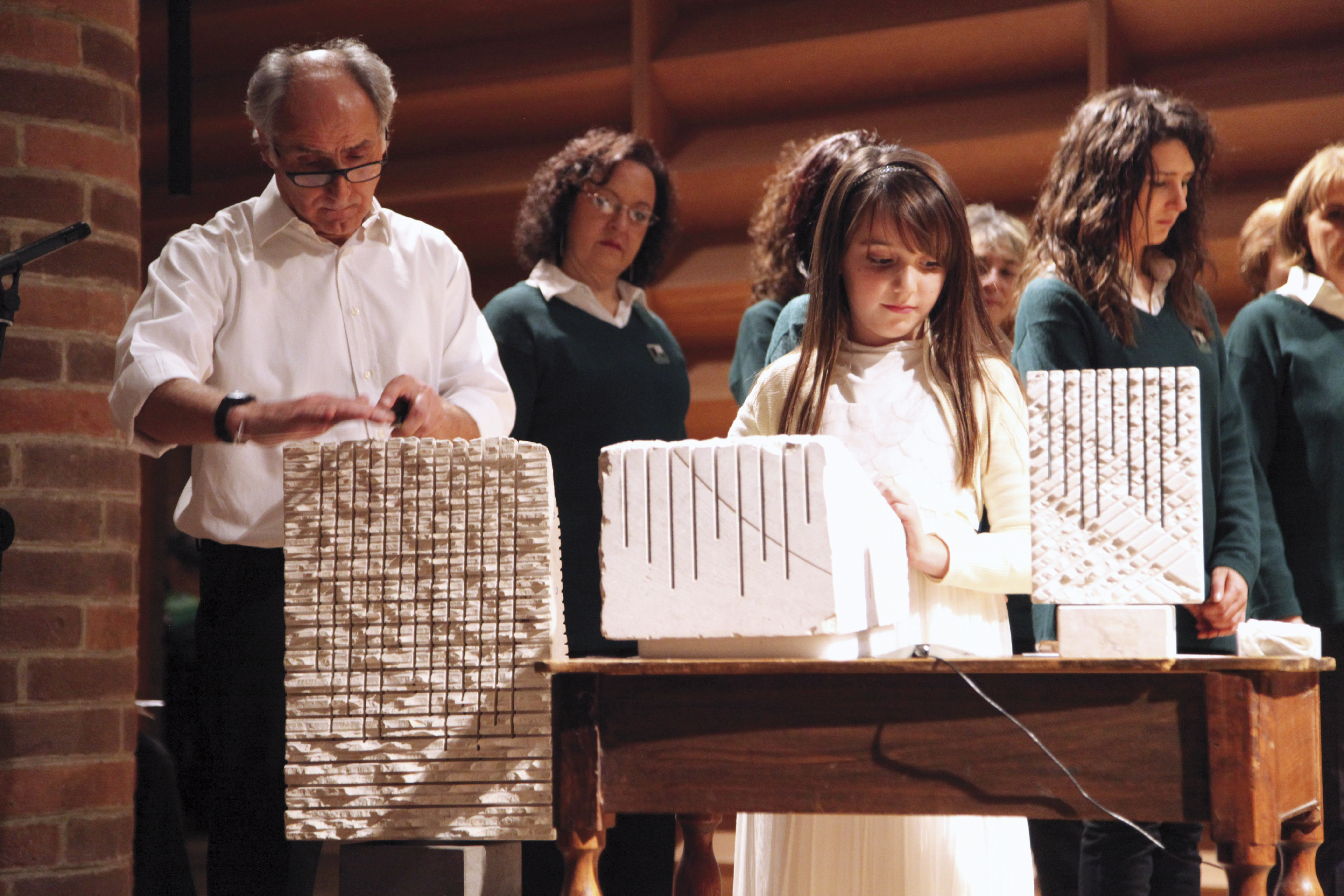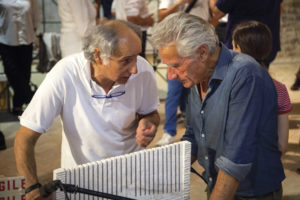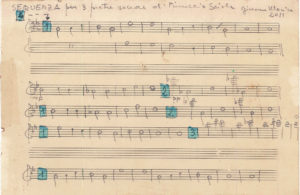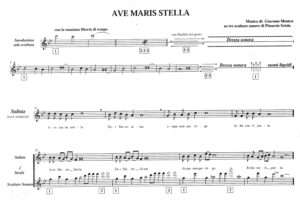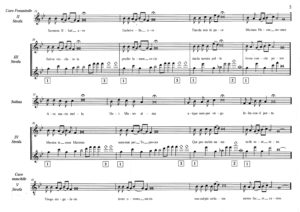By Giacomo Monica, choir director and teacher
1. The Harmonious Aesthetic Beauty
A possible dialogue between the sounds of the stones (voice of nature) and the human voice (in the choir)
The question arises spontaneously: Why talk about a sculpture in a music-focused magazine such as the ICB, which deals with various genres, styles, and subsequent interpretations and performance practices? Why talk about sculpture in a magazine that uniquely deals with rediscovering composers and unknown or infrequently performed—but still important—compositions, or that faces issues related to instruments, choirs, voice, and the relevant techniques of support?
If the essence of everything (in a broader sense) is the voice, and the voice is sound, then one can also question the origin of the sound: how it was born, from which material it is released, what characteristics it has, what the resonant areas are, what its expressive power is, and so on …
With the sonorous-sculptures by Pinuccio Sciola, one enters an ancestral dimension, magical but real at the same time, in which one understands very well the concept, fundamental to every musician, that sound comes from silence. Just like that, as if through an association of ideas, our mind takes us back to the title of the technical choral book by Fosco Corti, “Breath is Already Singing,” or to the writings of Y. Menuhin, “Music and Interior Life.”
Sound has existed since the primordial era, before existing in man’s vocal cords. It existed in the stone before the birth of light … (so says the sculptor). It is wonderful, and not utopian, to think that the voice exists in everything—in humans as well as in stones—and that this is the secret soul of mystery. When not trapped or suffocated, but, on the contrary, made free, sound of any given nature engages us in dialogue.
It is not inconceivable for contemporary composers, whose innovative languages are continually improving exploration, to find meaning not only in Pinuccio Sciola’s sculptures as “sound furniture,” but as a significant form of primary language. This language can be explicated in a direct way and becomes a dialogue between the element nature-stone and the man singing-voice-sound.
Being able to unify the arts and breaking the mental barriers that are easily interposed and prevent the passage from one discipline to another, means making a small step forward in the understanding of the art itself. In this case, this means making sure that polyphony and litophony (voice-stone) are complementary and compensatory to each other, as is normally the case between acting and singing.
The voice between nature and man, between breath and song, between matter and soul, between technique and art—this voice remains the essence of everything.
2. The Meaning of the compositional Research in Dialogue with the Voice
How to interpret and play the sculptures
This is why, in my opinion, one should not claim to invent a composition with the sonorous-sculptures by Pinuccio Sciola (different musicians have been trying to write and experiment to this end); these are living sculptures that you must know how to interpret in the true sense of the word. Each of them speaks a different language in relation to the physical properties of sound (pitch, intensity, timbre), in relation to the shape, size, weight, spaces, and calibre of the stone strings, in relation to the depth of the cuts and to the type of stress.
The composition is already inside the stone, which speaks its own language. Everything has a specific starting code that can be used for expressive purposes. In the matrix there is already a predetermined skeleton that suggests those interpretative solutions on the condition that there is the desire to pursue a deep and meditative listening, in order to better bring out the sound and propose it again. Centuries of history have given us wonderful sculptures in three dimensions that still enchant us today; also, in a past very close to us, other artists were measured by moving sculptures creating four dimensions. Some, with sculptures that produce mechanical noises, fall within the field of experimentation five dimensions. Pinuccio Sciola went beyond this, creating a six-dimensional sculpture that enchants because the stone sings.
The absence of barriers between the vibrations of the rock and the vibrations of the vocal cords becomes obvious in the study of the composition, so that research is explicit regarding this concept of exchange and compensation. The “freeze” sound of the human voice counteracts these sounds liberated from the stone in a continuous bounce-back between the sung word and the sound. The voice of nature, in exact correspondence with the human voice, creates a sort of primordial symbiosis that can become awoken and animated.
After the sculptor’s hand has created the artwork in limestone or basalt, it remains for the musician to complete the delicate task of interpreting what emerges, allowing the sculptures to communicate among themselves or join the human voice. Communicating the beauty of this new expressive resource is of profound interest to me—not for simplistic and superficial reasons, and not in order to surprise or worse, for dramatic effect; but for insight into the pulse of a new dimension that has more value and represents the essence of a language not only formal and aesthetic, but above all, alive, edgy, ethereal and vibrant.
3. Two compositional Examples
Sound profiles (with text by Yehudi Menuhin)
Concatenation of sounds in their mystical colour
Lasting about 4 minutes
From the limestone sculptures emerge monodic lines, as short Gregorian sequences, in succession, whose pitch is the random result, linked both to the cut of the material desired in terms of shape, of aesthetics, of depth and thickness by the sculptor, and to the conformation of matter for its more or less compressed and sedimented cells. The sonic soul of the matter, with its uniqueness (each sculpture contains a sort of genetic code, with musical notes, unique and unchangeable), imposes itself, with its strengths and limitations, on the musician looking for a creative path. The litho strings solicited emit tones, sound, colours, and atmospheres to the limit of hearing, which may float in silence and speak to us.
And it is from silence that the sound is generated and arrives. The structure of the piece consists of four short periods (played with a bow on one sculpture and flowered with complementary sounds of reflection obtained from other sculptures) all preceded by a short reading on the value of silence, a result of the reflection of the great violinist, interpreter and teacher Yehudi Menuhin.
The value of silence (from “Music and inner life”)
Yehudi Menuhin
Silence. Asking a musician to say something which is apparently the opposite of what it represents may seem absurd, or at least paradoxical. But let me try to explain what the silence means to me as a musician.
This church so beautifully offers an example of peace and allows us to carefully explore the profound meaning of this word. Is silence not “the very essence of what we hope, of everything that has not yet been fulfilled”? In this terribly crowded world, silence became absence, an emptiness we try to fill with our small talk rather than with real substance, with something deeper, for example with faith. What is unfulfilled? Is it not a sweet, small voice that we can no longer perceive in the terrible noise that filled our lives?
The silence is calmness, not emptiness; it is clarity but not absence of colour; it is rhythm like that one expressed by a healthy heart; it is the foundation of every thought, of true creativity. From silence comes all that lives and remains; whoever keeps the silence inside may impassively face the outer noise because silence connects us to the universe, to the infinite. It is the very root of existence and gives balance to life. The silence is tangible and intangible at the same time, and it is in this sense that I dare to call it music.
AVE MARIS STELLA
Composition in which the human voice interacts with the sounds of nature
for sculptures, voice and choir
Lasting about 5 minutes
The sonorous-sculptures interact with the human voice and overlap moments in which a kind of archaic counterpoint is created for two voices. Nature-man, matter-spirit, silence-sound, in a junction between the tangible and the abstract. The religious text on the purity of Mary, Star of the Sea, accompanies and plays all those sounds that the limestone, born of water, return to liquid form to echo and to sing according to nature.
4. ASPECTS OF TEACHING AND LEARNING
Discovering and feeling the matter with different eyes
For every child, finding that sound is inside all elements of nature, and therefore also inside the stone (which by definition is classified among the cold elements, static, inert, and lifeless), is an immense joy that brings absolute amazement; the child remains silent in the face of a stone that speaks, sings, and tells … that wants to talk to him.
How important is it for a child to understand that sound comes from silence?
And that is not easy to listen to the silence?
But stones also suggest this.
Every child can use their own hands and sense of touch to caress, rub, beat, and play Pinuccio Sciola sculptures and immediately empathize. Every child can play with the stones so as to find many positive outlets for their sensitivity and curiosity. Curiosity is very significant because it signifies intellectual growth.
Every child who discovers the aesthetic and harmonious beauty, refined and delicate, approaches the art, concretely discovering its intrinsic characteristics and realizing that the arts are linked to one another. Dance, for example, is linked to sound and movement. Calder’s sculptures of leaves, light and suspended, are linked to sound as well, as are Tinguley or Munari’s sculptures, deliberately focused on the noise caused by movement. Then, progressing further chronologically, we come to the Bertoia sculptures that, when touched, trigger clusters of deafening sounds.
However, the child realizes that Sciola’s sonorous-sculptures are not ordinary objects, but living things that belong to him and that contain a sonorous soul kept inside the stone.
Playing a sculpture is also a very wonderful opportunity to get closer to the magical world of music. The child begins to understand, to see, and hear the matter in a different way, their careful ears and mind prepared for an active but amusing lesson. It’s amusing to think that the sculpture can be turned into a game.
5. Link and Videos
Sound Profiles
Ave Maris Stella
Edited by Nina De Palma, USA

